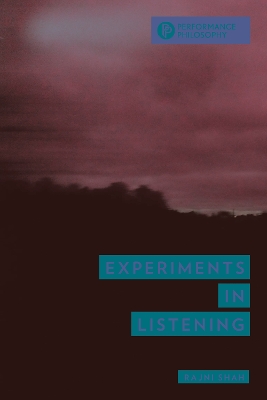Performance Philosophy
1 total work
Through an exploration of both practice and theory, this book investigates the relationship between listening and the theatrical encounter in the context of Western theatre and performance. Rather than looking to the stage for a politics or ethics of performance, Rajni Shah asks what work needs to happen in order for the stage itself to appear, exploring some of the factors that might allow or prevent a group of individuals to gather together as an ‘audience’.
Shah proposes that the theatrical encounter is a structure that prioritises the attentive over the declarative; each of the five chapters is an exploration of this proposition. The first two chapters propose readings for the terms ‘listening’ and ‘audience’, drawing primarily on Gemma Corradi Fiumara’s writing about the philosophy of listening and Stanley Cavell’s writing about being-in-audience. The third chapter reflects on the work of Lying Fallow, the first of two practice elements which were part of this research, asking whether and how this project aligns with the modes of listening that I have proposed thus far, and introducing Eve Kosofsky Sedgwick’s writing about the preposition ‘beside’ in relation to being-in-audience. In the fourth chapter, I examine the role of invitation in setting up the parameters for being-in-audience, in relation to Sara Ahmed’s writing about arrival and encounter. And in the final chapter the second practice element, Experiments in Listening, operates to expand our thinking about where and how the work of being-in-audience takes place.
Blending the boundaries of theoretical, creative and practice-based artistic work, this book is accompanied by a series of five zines. These describe an embodied experience of knowledge from a personal perspective, both playfully and seriously following a line of enquiry developed in each of the chapters.
Shah proposes that the theatrical encounter is a structure that prioritises the attentive over the declarative; each of the five chapters is an exploration of this proposition. The first two chapters propose readings for the terms ‘listening’ and ‘audience’, drawing primarily on Gemma Corradi Fiumara’s writing about the philosophy of listening and Stanley Cavell’s writing about being-in-audience. The third chapter reflects on the work of Lying Fallow, the first of two practice elements which were part of this research, asking whether and how this project aligns with the modes of listening that I have proposed thus far, and introducing Eve Kosofsky Sedgwick’s writing about the preposition ‘beside’ in relation to being-in-audience. In the fourth chapter, I examine the role of invitation in setting up the parameters for being-in-audience, in relation to Sara Ahmed’s writing about arrival and encounter. And in the final chapter the second practice element, Experiments in Listening, operates to expand our thinking about where and how the work of being-in-audience takes place.
Blending the boundaries of theoretical, creative and practice-based artistic work, this book is accompanied by a series of five zines. These describe an embodied experience of knowledge from a personal perspective, both playfully and seriously following a line of enquiry developed in each of the chapters.
